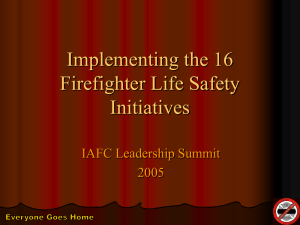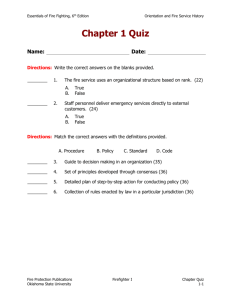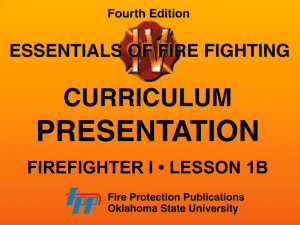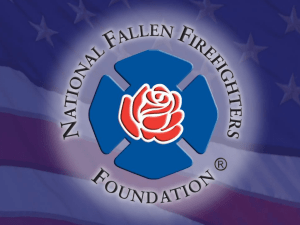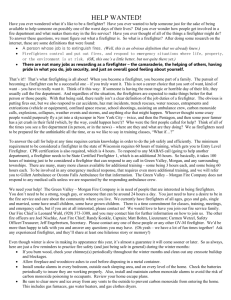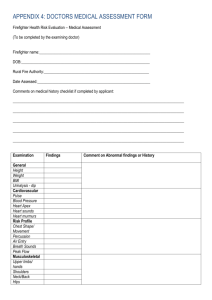Apparatus Driving and Operations
advertisement
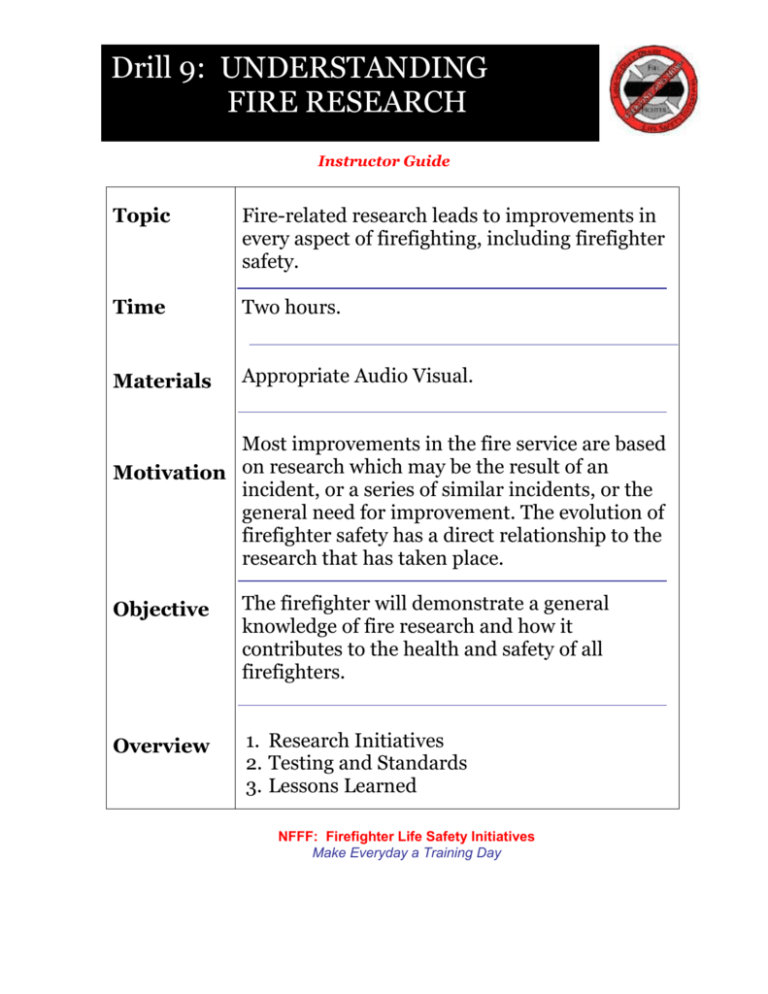
Drill 9: UNDERSTANDING FIRE RESEARCH Instructor Guide Topic Fire-related research leads to improvements in every aspect of firefighting, including firefighter safety. Time Two hours. Materials Appropriate Audio Visual. Most improvements in the fire service are based Motivation on research which may be the result of an incident, or a series of similar incidents, or the general need for improvement. The evolution of firefighter safety has a direct relationship to the research that has taken place. Objective The firefighter will demonstrate a general knowledge of fire research and how it contributes to the health and safety of all firefighters. Overview 1. Research Initiatives 2. Testing and Standards 3. Lessons Learned NFFF: Firefighter Life Safety Initiatives Make Everyday a Training Day National Fallen Firefighters Foundation Firefighter Life Safety Initiatives Program www.everyonegoes.home UNDERSTANDING FIRE RESEARCH The firefighter will demonstrate a general knowledge of fire research and how it contributes to the health and safety of firefighters. Identify various research initiatives that have contributed to improving the safety and health of firefighters. Describe the importance of testing and standards as part of the fire research process. Identify sources of lessons learned that can be used in fire research. 2 National Fallen Firefighters Foundation Firefighter Life Safety Initiatives Program www.everyonegoes.home Note: This drill could be more beneficial for all involved if it were conducted as an interactive discussion with the instructor leading the discussion. It should be an opportunity for personnel to reflect on how research has contributed to improving the health and safety of firefighters. The discussion would be enhanced by having a broad range of experience among the participants so that the progression of tools, equipment, apparatus, and training can be discussed based on first-hand knowledge. I. RESEARCH INITIATIVES A. Equipment 1. Personal protective clothing a. Turncoat coat and pants design and fabric, e.g., from rubber and canvas duck to Nomex and PBI b. Helmet design and material, e.g., from metal to materials that do not conduct electricity c. Eye protection design, e.g., from fold-down helmet eye shields to specifically designed goggles d. Glove design and material, e.g., from rubber coated “fireball” gloves to specially treated leather materials e. Hood adaptation 2. Self-contained breathing apparatus a. Operation, e.g., from negative pressure and mainline controls to positive pressure and mask mounted regulators b. Quick fill or buddy breathing c. Integrated PASS device that are turned on automatically when the cylinder is turned on (reduces human intervention) d. Cylinder capacity, size, and weight, e.g., from steel and aluminum cylinders to smaller, lighter weight composite cylinders (accomplished by increasing pressure and reducing cylinder size) e. Facepiece spider design and material, e.g., from rubber spiders to Nomex and PBI webbing that provides a better seal 3. Accountability systems a. Development of systems b. Use of accountability tags c. Incorporation into incident management system d. Use of electronic devices to monitor the location of personnel e. Personnel Accountability Report (PAR) as part of the incident management system 3 National Fallen Firefighters Foundation Firefighter Life Safety Initiatives Program www.everyonegoes.home 4. Nozzles a. Automatic nozzles that operate with constant pressure and variable flow b. Refinement of piecing nozzles c. Variable gallonage nozzles to meet flow requirements d. Low pressure nozzles e. Increased GPM nozzles flow to take advantage of larger size attack lines f. 5. Hose a. Large diameter hose for supply lines in place of 2-1/2-inch and 3inch lines b. 1-3/4-inch and 2-inch to increase flow over 1-1/2-inch lines c. Standardized couplings to increase interoperability d. Synthetic fabric to reduce the need for drying 6. Aqueous film forming form (AFFF) a. Increased shelf life over protein foam b. Good penetrating capabilities c. Spreads vapor-sealing film over and floats on hydrocarbon fuels d. May be more versatile e. Can be used with conventional nozzles 7. Thermal imaging technology a. Improves visibility in smoke-filled environment b. Reduces search time c. Can be used to detect hot spots as well as locate victims B. Apparatus 1. Fully enclosed cabs a. Provides a safer passenger transport area b. Removes personnel from weather elements when responding or returning c. Better opportunity to hear radio transmissions d. Better opportunity for communications between officer and personnel e. Provides an area where personnel can be seated and restrained while apparatus is in motion f. Noise reduction 2. Emergency lighting placement a. Improves visibility in traffic 4 National Fallen Firefighters Foundation Firefighter Life Safety Initiatives Program www.everyonegoes.home b. Potential for reducing accidents involving emergency apparatus c. Improves safety at the emergency scene 3. Other safety features a. Rollover protection for apparatus b. Vehicular operation and handling (center of gravity) c. Layout and placement of equipment on apparatus for ease of access and removal d. Various safety systems such as airbags, open door or compartment warnings, color coded seatbelts, unbuckled seatbelt warnings, etc. C. Training 1. Professional development through the development of standards to establish minimum training levels based on job requirements with consideration for personal safety a. NFPA 1001, Fire Fighter Professional Qualifications b. NFPA 1002, Fire Apparatus Driver/Operator Professional Qualifications c. NFPA 1006, Rescue Technician Professional Qualifications d. NFPA 1021, Fire Officer Professional Qualifications e. NFPA 1041, Fire Service Professional Qualifications f. NFPA 472, Professional Competence of Responders to Hazardous Materials Incidents 2. Training techniques a. Realistic training based on standard operating procedures b. Simulation using computer-based technology c. Training props to enhance comprehension of material d. Skills development and maintenance especially basic skills e. Knowledge and skills evaluation to determine satisfactory completion of training f. Techniques used to deliver training 3. Training materials a. Standardized materials based on professional qualifications standards and generally accepted practices and techniques b. Audio-visual materials to support training c. Realistic training props D. Other 1. Firefighter line of duty deaths 5 National Fallen Firefighters Foundation Firefighter Life Safety Initiatives Program www.everyonegoes.home 2. 3. 4. 5. 6. a. Determine causes of firefighter fatalities b. Identification of trends and patterns c. Development of programs to reduce firefighter fatalities Interoperability a. Importance in multiple jurisdictional responses b. Must be considered with mutual aide programs c. Affects every area of the fire service from communications between on-scene units to fire hose threads and the ability to connect on a multiple alarm incident d. Can affect the efficiency of the operation National Incident Management System (NIMS) a. Extension of the incident management system to non-fire agencies b. Necessary because of large scale incidents or responses to terrorist incidents c. Incorporates responses beyond the local fire service or local government d. Tiered based on the level and complexity of the incident Incident Command System a. Adapted from West Coast wildland fire management b. Improves emergency scene accountability and resource management c. Modular based on the magnitude and complexity of the emergency d. Necessary element in successfully managing any incident regardless of size and nature Health and wellness a. Programs developed based on study of firefighter deaths and injuries as well as general industry practices b. Important element in providing efficient and effective service by personnel being prepared physically and mentally to respond c. Important component in any training program d. Must be considered on a regular basis to prepare to any incident e. Important in managing the workers’ compensation insurance program by reducing the potential for injury Two-in/two-out a. Required by OSHA 29 CFR 1910.134 (Respiratory Protection) b. Included in NFPA 1500 (Fire Department Occupational Safety and Health Program) c. Important element in providing for the safety of fire personnel d. Must be included in departmental training programs and practiced 6 National Fallen Firefighters Foundation Firefighter Life Safety Initiatives Program www.everyonegoes.home e. Not an option when operating in an IDLH (immediately dangerous to life and health) environment f. Requires the dedication of personnel to serve on firefighter rescue teams II. TESTING AND STANDARDS Developed and updated based on research and statistical data A. Examples of applicable NFPA standards 1. 2. 3. 4. 5. 6. NFPA 1403, Live Fire Training Evolutions NFPA 1500, Fire Department Occupational Safety and Health Program NFPA 1901, Automotive Fire Apparatus NFPA 1911, Service Tests for Fire Pump Systems on Fire Apparatus NFPA 1914, Testing Fire Department Aerial Devices NFPA 1932, Use, Maintenance, and Service Testing of In-Service Fire Department Ground Ladders 7. NFPA 1962, Inspection, Care, and Use of Fire Hose, Couplings, and Nozzles, and the Service Testing of Fire Hose 8. NFPA 1971, Protective Ensemble for Structural Fire Fighting 9. NFPA 1981, Open-Circuit Self-Contained Breathing Apparatus for Fire and Emergency Services B. Examples of Occupational Safety and Health Administration regulations 1. 29 CFR 1910.134 (Respiratory Protection) – annual respiratory protection equipment training, annual facepiece fitness test, and twoin/two-out requirement 2. 29 CFR 1910.120 (Hazardous Waste and Emergency Response) – emergency response to hazardous materials incidents including incident management system, training, and incident action plan 3. 29 CFR 1910.1200 (Hazard Communications) – communication of potential hazardous in a work area such as the presence of hazardous materials 4. 29 CFR 1910.1030 (Bloodborne Pathogens) - infectious disease control program C. Other testing and standards-making organizations that conduct or utilize research and contribute to firefighter safety and health 1. Underwriters Laboratories involvement 7 National Fallen Firefighters Foundation Firefighter Life Safety Initiatives Program www.everyonegoes.home a. Testing and evaluation of products b. Considered a neutral third party for manufacturers c. Nationally recognized 2. American National Standards Institute (ANSI) a. Develops standards for certain industrial equipment b. Standards apply to head protection and foot protection used in the fire service c. Standards may be referenced by NFPA III. LESSONS LEARNED A. Firefighter fatality study 1. Designed to identify causes of firefighter fatalities so that measures can be taken to reduce future fatalities 2. May address contributing factors that lead to the death as well as the cause of the death itself (lifestyle, family history, etc.) 3. Important element in reducing firefighter deaths 4. More information available at www.usfa.fema.gov/fatalities B. Firefighter close calls 1. Monthly feature of Firehouse Magazine 2. Opportunity to learn from others 3. Designed to improve safety awareness 4. Departments should be willing to share information in the interest of preventing similar occurrences elsewhere 5. More information at www.FirefighterCloseCalls.com C. Near miss initiative 1. New initiative the International Association of Fire Chiefs 2. Designed to call attention to actions that could have resulted in a mishap but did not 3. Intended to document near-misses in addition to close calls, and deaths and injuries 4. Designed to improve safety awareness 5. Should include the widest area of participation to achieve maximum benefit 6. To report an incident (can be done anonymously and confidentially) or obtain further information, go to www.Firefighternearmiss.com D. USFA technical report series 8 National Fallen Firefighters Foundation Firefighter Life Safety Initiatives Program www.everyonegoes.home 1. Investigative reports on certain incidents 2. Designed to share lessons learned 3. Available through www.usfa.fema.gov at no cost E. Data collection and analysis 1. Basis for any research or used to support research initiatives 2. Used in the development or updating of standards 3. May form the basis for developing test methods 4. Examples of national data collection and analysis systems a. National Fire Incident Reporting System (NFIRS) of the United States Fire Administration b. Uniform Fire Incident Reporting System (UFIRS) of the National Fire Protection Association c. Consumer Product Safety Commission – tests product failures 5. National Institute for Standards and Technology a. Building products research b. Fire investigations c. Fire protection system research d. Research done in connection with the United States Fire Administration 6. National Institute for Occupational Safety and Health a. Investigates workplace incidents b. May also investigate equipment or system failures c. Technical reports issued d. Investigations may result in citations F. Future 1. When funding is reduced, one of the first items to be affected in research and development 2. There may not be a financial incentive for private industry to undertake research and development efforts due to the limited fire service market and return on investment 3. National fire service organizations need to set national priorities for research, work to obtain funding to support those priorities, and support the priorities 4. There is a constant need for timely and accurate data collection, analysis, and dissemination 5. The fire service needs to look at other fields to determine if technology that can improve the health and safety of firefighters can be adapted to 9 National Fallen Firefighters Foundation Firefighter Life Safety Initiatives Program www.everyonegoes.home the fire service rather than continuing to reinvent the wheel or work in a vacuum 6. If the annual number of firefighter line of duty deaths is to be reduced, research initiatives must be identified and funded and the results shared and implemented REVIEW: UNDERSTANDING FIRE RESEARCH * Research Initiatives * Testing and Standards * Lessons Learned REMOTIVATION: While research is very important to the evolution of the fire service, benefiting from past experience and events is also important. If we do not take advantage of changes in technology and the lessons learned, we are destined to repeat past mistakes. We must also make sure that the necessary resources are provided to that the health and safety of personnel can continue to be improved. 10 National Fallen Firefighters Foundation Firefighter Life Safety Initiatives Program www.everyonegoes.home Apply the Drill (Instructor may assign this drill to test comprehension and mastery of skills presented) References Additional Resources Choose one aspect of firefighting where you think further research would yield great benefits. Topics could firefighter protective gear, fireground communications, vehicle improvements or another topic approved by instructor. Develop a one page proposal for a research project, which will include: statement of the problem, why research could make improvements, type of research needed (i.e. laboratory, theoretical, comparative), and how research project could be conducted. If project involves funding, speculate on how such funding could be obtained. (For example; apply for a FIRE Act grant.) Essentials of Fire Fighting, 4th ed., International Fire Service Training Association, 1998. The United States Fire Administration provides excellent material to support fire service research. At its website (www.usfa.fema.gov) consult the following: National Fire Data Center: Topical Research Series U.S. Fire Statistics Fire Data Analysis Handbook Research Projects-USFA Research Initiatives USFA Fire Research Agenda Learning Resource Center (LRC) on-line Catalog National Institute of Standards & Technology (NIST), Building and Fire Research Laboratory (BFRL) provides Fire Research Information Services (FRIS) to researchers around the world. FRIS has more than 55,000 items in its collection, including published reports, journal articles, conference proceedings, books and audiovisual items. Go to www.bfrl.nist.gov/fris. inFIRE is an international network for Fire information and 11 National Fallen Firefighters Foundation Firefighter Life Safety Initiatives Program www.everyonegoes.home Reference exchange—a worldwide network of libraries dedicated to fire-related literature. Membership fee. Visit www.inFIRE.org The NFPA’s One-Stop Data Shop provides excellent reports, many of which may be downloaded for free to nonmembers. NFPA members are entitled to research reports and research-related documents. There are a number of journals and periodicals which publish regularly publish fire-related research: Fire Engineering Fire Chief Fire Technology Firehouse (see www.firehouse.com) Other subject-specific periodicals can be researched at the National Fire Academy’s Learning Resource Center OnLine Catalog www.usfa.fema.gov. 12

